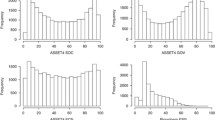Abstract
This paper aims to determine the relationships, if any, between the green ratings, deemed as eco-efficiency by employing a structural equations model (SEM) to determine the relationship between the Newsweek Green Rankings and the Global Fortune 500 Corporations. The methodology includes the analysis of four sustainability variables and four social responsibility variables evaluated in the Newsweek Green Rankings to study if there is a relationship between the implementation of such variables and the operational profitability performance and the possibility of the reduction of adverse risk effects in their continued operations. The objective of this paper is to provide empirical evidence that states the benefit of implementing eco-efficiency variables in their operations.

Similar content being viewed by others
References
Asif, M., Searcy, C., Zutshi, A., & Fisscher, O. A. M. (2011). An integrated management systems approach to corporate social responsibility. Journal of Cleaner Production, 56, 7–17.
Baird, P. L., Geylani, P. C. & Roberts, J. A. (2012). Corporate social and financial performance re-examined: Industry effects in a linear mixed model analysis. Journal of Business Ethics, 109, 367–388.
Bertoldi, P., Rezessy, S., & Oikonomou, V. (2013). Rewarding energy savings rather than energy efficiency: Exploring the concept of a feed-in tariff for energy savings. Energy Policy, 523–535.
De la Cuesta, M., Munoz, M., & Fernandez, M. (2006). Analysis of social performance in the Spanish financial industry through public data: A proposal. Journal of Business Ethics, 289–304.
Derwall, J., Guenster, N., Bauer, R., & Koedijk, K. (2005). The eco-efficiency premium puzzle. Financial Analysts Journal, 61, 51–63.
Dion, P. (2008). Interpreting structural equation modeling results: A reply to Martin and Cullen. Journal of Business Ethics, 83, 365–368.
Hillman, A., & Keim, G. (2001). Shareholder value, stakeholder management, and social issues: What’s the bottom line? Strategic Management Journal., 125.
Karma, O., & Sander, P. (2006). The impact of financial leverage on risk of equity measured by loss-oriented risk measures: An option pricing approach. European Journal of Operational Research, 175, 1340–1356.
Marom, I. Y. (2006). Toward a unified theory of the CSP–CFP link. Journal of Business Ethics, 67, 191–200.
Newsweek. (2014–16). Newsweek Green Rankings. New York: Newsweek.
R Core Team. (2013). R: A language and environment for statistical computing. Vienna: Austria.
Roman, R., Hayibor, S., & Agle, B. (1999). The relationship between social and financial performance: Repainting a portrait. Business and Society, 109.
Sinkin, C., Wright, C., & Burnett, R. (2008). Eco-efficiency and firm value. Journal of Accounting and Public Policy, 27, 167–178.
Standard & Poor's/Compustat. (2017). Compustat global financial database. Retrieved from Retrieved from Wharton Research Data.
Stanwick, P., & Stanwick, A. (1998). The relationship between corporate social performance and organizational size, financial performance, and environmental performance: An empirical examination. Journal of Business Ethics, 17, 195–204.
Statman, M. (2000). Socially responsible mutual funds. Financial Analysts Journal, 56, 30–39.
United Nations. (1993). Conference on the environment and development. Report of the United Nations Conference on Environment and Development, Rio de Janeiro, 3–14 June 1992: Statements made by heads of state or government at the summit segment of the Conference (pp. 1–254). New York: United Nations.
van Beurden, P., & Gossling, T. (2008). The worth of values—A literature review on the relation between corporate social and financial performance. Journal of Business Ethics., 407.
Van den Venter, G., Michayluk, D., & Davey, G. (2012). A longitudinal study of financial risk tolerance. Journal of Economic Psychology, 33, 794–800.
Waddock, S. A., & Graves, S. B. (1997). The corporate social performance–financial performance link. Strategic Management Journal., 303.
Author information
Authors and Affiliations
Corresponding author
Ethics declarations
Conflict of interest
The authors declare that they have no conflict of interest.
Additional information
Publisher’s note
Springer Nature remains neutral with regard to jurisdictional claims in published maps and institutional affiliations.
Rights and permissions
About this article
Cite this article
García-Piña Rosete, J.C., Hernandez Barros, R. & Blanco-Jiménez, M. SEM analysis on Global Fortune 500 Corporations with green ratings. Energy Efficiency 13, 1135–1145 (2020). https://doi.org/10.1007/s12053-020-09876-2
Received:
Accepted:
Published:
Issue Date:
DOI: https://doi.org/10.1007/s12053-020-09876-2




